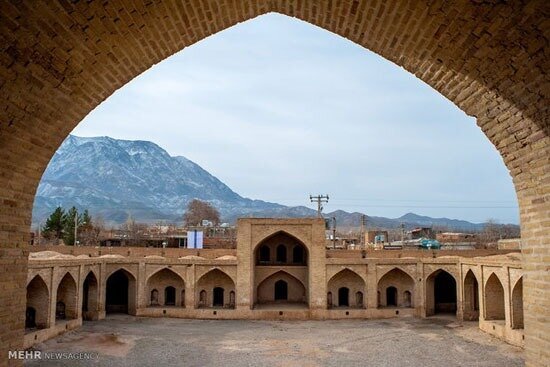Once highly-prosperous caravanserai undergoes restoration

TEHRAN – One of the once highly prosperous Shah-Abbasi caravanserais, which is located in Mayamey town of Semnan province, has undergone some rehabilitation works, a local tourism official announced on Wednesday.
The project aims to prepare the historical structure that will soon be visited by the assessors and experts affiliated with the International Council on Monuments and Sites (ICOMOS), Seyyed Mohammad Sadeq Razavian said.
The assessors are slated to explore the caravanserai by the end of the current Iranian month of Mordad (August 22) for possible inscription on the UNESCO World Heritage list, the official said.
The project involves repairing the damaged parts as well as strengthening the historical inn, the official added.
“As the caravanserai is relatively undamaged and stable, and because of its convenient location on the Tehran-Mashhad road, it could be repurposed and ceded to the private sector for better maintenance and use,” he explained.
There are four iwans (porches) and two entrances in this caravanserai that sprawls across 8,500 square meters. The courtyard is surrounded by rooms and platforms, and behind the rooms are stables. Unlike most caravanserais, the sanitary facilities of the caravanserai are located outside the building and on the western side.
The structure is named after Shah Abbas the Great (r. 1588 – 1629), who ordered the construction of such roadside inns across the country. The mudbrick structure was inscribed on the National Heritage list in 1986.
The historical structure of Mayamey includes several caravanserais, natural sights, and historical sites such as Shah-Abbasi caravanserai, Aqaian Mosque, Aqaian Mansion, Aqaian bathhouse, and Emarat cistern.
The main population centers of Semnan province lie along the ancient Silk Road (and modern-day Imam Reza Expressway), linking Rey (Tehran) with Khorasan (Mashhad). While few visitors spend much time in the area, driving through you can easily seek out several well-preserved caravanserais (notably Dehnamak and Ahowan), cisterns (the Cafe Abenbar in Garmsar is a special treat), and ruined mud citadels (Padeh is lumpy but fascinating). The large, bustling cities of Semnan, Damghan, and Shahrud (Bastam) all have a small selection of historic buildings and Semnan has a fine old covered bazaar.
Iranian caravanserais being ready for collective UNESCO tag
An all-inclusive dossier of a select of Iranian caravanserais is being prepared to be evaluated during the next session of the World Heritage Committee, which will be held in 2022.
Last year, the tourism ministry announced that Iran is developing a dossier for a selection of its historical caravanseries for a possible inscription on the UNESCO World Heritage list. In this regard, cultural heritage experts are assessing such monuments that are scattered across the country to make a shortlist in terms of their architecture, historical and cultural values.
Caravansary is a compound word combining “caravan” with “sara”; the former stands for a group of travelers and the latter means the building. They often had massive portals supported by elevated load-bearing walls. Guest rooms were constructed around the courtyard and stables behind them with doors in the corners of the yard.
Iran’s earliest caravanserais were built during the Achaemenid era (550 -330 BC). Centuries later, when Shah Abbas I assumed power from 1588 – to 1629, he ordered the construction of network caravanserais across the country. For many travelers to Iran, staying in or even visiting a centuries-old caravanserai, can be a wide experience; they have an opportunity to feel the past, a time travel back into a forgotten age!
The Islamic Republic expects to reap a bonanza from its numerous tourist spots such as bazaars, museums, mosques, bridges, bathhouses, madrasas, mausoleums, churches, towers, and mansions. Under the 2025 Tourism Vision Plan, Iran aims to increase the number of tourist arrivals from 4.8 million in 2014 to 20 million in 2025. The latest available data show eight million tourists visited the Islamic Republic during the first ten months of the past Iranian calendar year (ended March 20).
ABU/AFM
Leave a Comment